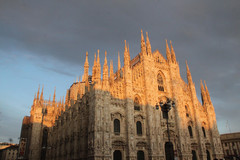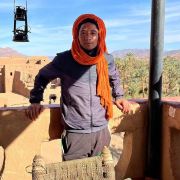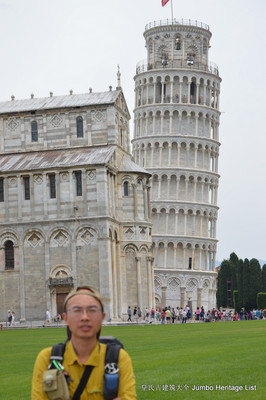
第474回:比萨斜塔歪打正着,建筑败笔因祸得福
出发时间
7月
行程天数
1天
人均花费
400
和谁出行
夫妻
【環遊尋美拾遺錄】【皇氏古建築大全】【黃劍博客圖文集】
【Jumbo Heritage List & The Globetrotting Adventure of Jumbo Huang】
第474回:比萨斜塔歪打正着,建筑败笔因祸得福

©原创图片(本图文中的图片版权归Jumbo Huang所有,任何形式转载请联系作者"Jumbo Huang":Jumbo_Huang@126.com,微信Jumboheritagelist)。本图志全部图片谢绝一切非完整性的截图转载!请自重,特别谢绝各种手工特意叠加商业网站水印的转载!本作品保留一切权利。

作品中图片不得直接或者间接用于以营利为目的一切商业行为,违者必究。本图文中部分章节文字内容可能局部来自公开网络或公有领域,仅供个人学习研究和欣赏而使用,没有明确商业用途。原创照片来源:《皇氏古建築大全》和《環遊尋美拾遺錄》及《黄剑博客图文集》)

璧飒临阿诺河,曾是利古里亚海岸港口,现已离海十公里,东距佛罗伦萨约七十公里。工业有金属加工、机械、纺织、陶瓷、玻璃、化学、制糖等;还产大理石与雪花石膏雕刻品。铁路和公路枢纽四通八达。设有建于1343年的璧飒大学,多中世纪建筑艺术。还有罗马式大教堂、博物馆与图书馆等。旅游业发达。

璧飒城历史上是个海滨城市。随着陆地的扩展,璧飒距海越来越远了,但这并不能使人遗忘璧飒曾作为海上共和国威镇八方的历史和它作为联结东西方纽带曾起的重要作用。而且正因为它的历史,它的建筑艺术,今日,璧飒已成为著名的旅游城市。

璧飒的名气,很大程度上是受惠于璧飒斜塔。随着时间的推移,璧飒塔的倾斜程度不断增大,目前已达到4.5米,而且倾斜度还以每年一毫米的速度继续增加,但最近几年当局开始“纠斜“,陆续出台了一些加固措施,效果明显。可能正是由于它的斜,和别人不一样,名气应了“歪打正着”的效应,变得越来越大,

参观者络绎不绝。璧飒塔及教堂周围还有残存的古城墙环绕,游客则集中在草坪区域,我们刚走进景区参观,就看到八个欧洲少女正坐在石头台阶上休息,这些美女全部都穿着性感的齐臀超级短裤,这种潮流如此流行,以至于我国的男人装杂志也开始收集美女穿齐臀短裤的玉照了。

欧洲少女通常都是结伴跟同龄的女孩一起出国游玩,但亚洲的少女就基本还是要跟父母结伴出游了,毕竟中国青少年的自持和防御色情侵蚀的能力都比较弱。璧飒斜塔其实是意大利璧飒城大教堂的独立式钟楼,位于璧飒城北面的奇迹广场上。广场的大片草坪上散布着一组宗教建筑,它们是建造于1063年到13世纪大教堂、洗礼堂、钟楼和墓园(建造于1174年),它们的外墙面均为乳白色大理石砌成,各自相对独立但又形成统一罗马式建筑风格。

这些建筑上的青铜雕刻和白色大理石雕刻都非常出众,甚至一些栏杆柱头上的裸体人物雕刻都非常逼真。我们经过大教堂的铁门口,看到一位亚洲黑发少女居然坐在台阶上拿出画笔临摹前方的位于璧飒大教堂的后面的璧飒斜塔。少女后面的铁门上分布着大量雕刻,我走近璧飒斜塔一看,还真倾斜得非常厉害了。

一群非常肥胖的印度妇女正凑在前面参观,她们浑身包裹严实,不久两个中国少女从我身边走过,其中那位长发及腰的少女也穿着紧身齐臀短裤,雪白的大腿和半露的翘臀吸引了不少欧亚男人的目光,她那洁白得犹如透明似的雪肌玉肤,娇嫩得就象蓓蕾初绽时的花瓣一样细腻润滑,让人头晕目眩、心旌摇动,不敢仰视。怎么说,还是中国美女长得细腻协调,虽然没有欧洲少女那么奔放大胆。

未几一群欧洲少女迎面走来,她们有说有笑,充满活力。我走近璧飒斜塔,发现其四周分布着很多酷似人猴的雕像,中间夹着老鹰头的雕刻,远处草坪上能看到一个石柱顶部有母狼给两个罗马小孩喂奶的雕像。有一些群众爬到璧飒斜塔的楼上参观,我们还看到一位摄影师爬到梯子上用非常传统的大画幅相机拍摄建筑物的细节。

璧飒斜塔从地基到塔顶高58.36米,从地面到塔顶高55米,钟楼墙体在地面上的宽度是4.09米,在塔顶宽2.48米,总重约14453吨,重心在地基上方22.6米处。圆形地基面积为285平方米,对地面的平均压强为497千帕。倾斜角度3.99度,偏离地基外沿2.5米,顶层突出4.5米。璧飒斜塔修建于1173年,它由著名建筑师那诺皮萨诺主持修建。1174年首次发现倾斜。

璧飒斜塔位于罗马式大教堂后面右侧,是璧飒城的标志。据说刚开始时,塔高设计为一百米左右,并设计为垂直建造,但动工五六年后,塔身从三层开始倾斜,直到完工还在持续倾斜,在其关闭之前,塔顶已南倾(即塔顶偏离垂直线)3.5米。1990年,意大利政府将其关闭,开始进行整修工作。在实际工作中,许多有关专家对璧飒斜塔的全部历史以及塔的建筑材料、结构、地质、水源等方面进行充分的研究,并采用各种先进的仪器设备进行测试。

璧飒中古史学家皮洛迪教授研究后认为,建造塔身的每一块石砖都是一块石雕佳品,石砖与石砖间的粘合极为巧妙,有效地防止了塔身倾斜引起的断裂,成为斜塔斜而不倒的一个因素。但他仍强调指出,当务之急是弄清璧飒斜塔斜而不倒的奥妙。从事观测该塔的专家盖里教授根据璧飒斜塔近几年来倾斜的速度推测出,斜塔将于250年后因塔身的重心超出塔基外缘而倾倒。

但是公共事务部璧飒斜塔服务局的有关人员,针对盖里教授的看法提出了反驳,认为只按数学方式推算是不可靠的,璧飒斜塔是“一个由多种事实交织成的综合性问题”。另一些研究者调查发现璧飒斜塔塔身曾一度向东倾斜,尔后又转向南倾斜,

他们同样认为该塔在过去几百年间斜而不倒,250年后倒与不倒恐怕不能局限于简单的假设和预测。当然最关心斜塔命运的自然是璧飒人,尽管他们也对斜塔的倾斜感到担忧,但更多的是骄傲和自豪,为自己的故乡拥有一个自认为可与世界上著名建筑媲美的斜塔而感到自豪。

他们坚信它不会倒下,他们有这样一句俗语,璧飒塔像璧飒人一样健壮结实,永远不会倒下去。他们对那些把斜塔重新纠正竖直的建议最为深恶痛绝。如1934年在地基及四周喷入90吨水泥,实施基础防水工程,塔身反而更加不稳,向周围移动,倾斜得更快。看来防止斜塔继续倾斜已经成为世界难题了。

璧飒大教堂钟楼由于地基不均匀和土层松软而倾斜,工程曾间断了两次很长的时间,历经约二百年才完工。在钟楼入口右侧墙上发现的碑铭记录了钟楼开始建造的年代:此钟楼奠基于公元1173年8月。过去人们曾一度认为钟楼是故意被设计成倾斜的,璧飒大教堂和璧飒斜塔形成了视觉上的连续性,但是事实并非如此。作为璧飒大教堂的钟楼,1173年8月9日开始建造时的设计是垂直竖立的,原设计为8层,高54.8米,也有人说要建100米高,它独特的白色闪光的中世纪风格建筑物,即使后来没有倾斜,也将会是欧洲最值得注意的钟楼之一。

璧飒斜塔为什么会倾斜,专家们曾为此争论不休。尤其是在14世纪,人们在两种论调中徘徊,璧飒斜塔究竟是建造过程中无法预料和避免的地面下沉累积效应的结果,还是建筑师有意而为之。

进入20世纪,随着对璧飒斜塔越来越精确的测量、使用各种先进设备对地基土层进行的深入勘测,以及对历史档案的研究,一些事实逐渐浮出水面:璧飒斜塔在最初的设计中本应是垂直的建筑,但是在建造初期就开始偏离了正确位置。据说在1178年,当钟楼兴建到第四层时发现由于地基不均匀和土层松软,导致钟楼已经倾斜偏向东南方,工程因此暂停。

期间的1198年,记载了钟楼内撞钟的存在,这标志着钟楼虽然倾斜,但至少悬挂了一个撞钟,实现了它作为钟楼的初衷。1231年,工程继续,第一次有记载钟楼使用了大理石。建造者采取各种措施修正倾斜,刻意将钟楼上层搭建成反方向的倾斜,以便补偿已经发生的重心偏离。1278年进展到第7层的时候,塔身不再呈直线,而是为凹形。工程再次暂停。1292年,皮萨诺用铅垂线测量了钟楼的倾斜度。根据现有的文字记载,璧飒斜塔在几个世纪以来的倾斜是缓慢的,它和它地基下方的土层实际上达到了某种程度上的平衡。

1360年,在停滞了差不多一个世纪后钟楼向完工开始最后一个冲刺,并作了最后一次重要的修正。1372年摆放钟的顶层完工。54米高的8层钟楼共有七口钟,但是由于钟楼时刻都有倒塌的危险而没有撞响过。而且一直不断地向下倾斜。所说璧飒斜塔下有好几层不同材质的土层,各种软质粉土的沉淀物和非常软的粘土相间形成,而在深约一米的地方则是地下水层。这个结论是在对地基土层成份进行观测后得出的。

最新的挖掘表明,钟楼建造在了古代的海岸边缘,因此土质在建造时便已经沙化和下沉。毕竟很久之前璧飒市是靠海的,所以现在的大片陆地可能是当初填海造陆形成的。然而1838年的一次工程导致了璧飒斜塔突然加速倾斜,

人们不得不采取紧急维护措施。当时有个建筑师在原本密封的斜塔地基周围进行了挖掘,以探究地基的形态,揭示圆柱柱础和地基台阶是否与设想的相同。这一行为使得斜塔失去了原有的平衡,地基开始开裂,最严重的是发生了地下水涌入的现象。这次工程后的勘测结果表明倾斜加剧了20厘米,而此前267年的倾斜总和不过5厘米。

1838年的工程结束以后,璧飒斜塔的加速倾斜又持续了几年,然后又趋于平稳,减少到每年倾斜约一毫米,塔身偏离“自然姿势”已有五米多。璧飒斜塔毫无疑问是建筑史上的一座重要建筑。在发生严重的倾斜之前,它大胆的圆形建筑设计已经向世人展现了它的独创性。虽然在更早年代的意大利钟楼中,采用圆形地基的设计并不少见,类似的例子可以在拉文纳、托斯卡纳和翁布里亚找到,但是,璧飒钟楼被认为是独立于这些原型,在更大程度上,它是在借鉴前人建筑经验的基础上,独立设计并对圆形建筑加以了发展,形成了独特的璧飒风格。

比如,钟楼的圆形设计被认为是为了同一旁的大教堂建筑形成反射而相对应,因此有意地模仿教堂半圆形后殿的曲线设计。更重要的是,钟楼与广场上对圆形结构的强调是相一致的,尤其是在宏伟的、同样是圆形的洗礼堂奠基以后,整个广场更像是有意设计成耶路撒冷复活教堂的现代版本。

这种的设计正来源于经典的古代建筑。钟楼的装饰格调继承了大教堂和洗礼堂的经典之作,墙面用大理石或石灰石砌成深浅两种白色带,半露方柱的拱门、拱廊中的雕刻大门、长菱形的花格平顶、拱廊上方的墙面对阳光的照射形成光亮面和遮荫面的强烈反差,给人以钟楼内的圆柱相当沉重的假象。

大教堂、洗礼堂和钟楼之间形成了视觉上的连续性。传说1590年,出生在璧飒城的意大利物理学家伽利略曾在璧飒斜塔上做自由落体实验,将两个重量不同的球体从相同的高度同时扔下,结果两个铅球几乎同时落地,由此发现了自由落体定律,推翻了此前亚里士多德认为的重的物体会先到达地面,落体的速度同它的质量成正比的观点。但是,伽利略的两个球体并非像传说中的一样一起落下,即使重力加速度不变,两个球体受到空气阻力影响,是不会一起落下的。这也就是为什么鹅毛和铅球不会一起降落的原因。

由于受到空气阻力,两个球体不能看作自由落体。但是伽利略的实验理论是正确的,在真空中,无论多重的物体,都遵循自由落体定律。据说伽利略在璧飒斜塔做自由落体实验的故事,记载在他的学生维维安尼在1654年写的《伽利略生平的历史故事》(1717年出版)一书中,但伽利略、璧飒大学和同时代的其他人都没有关于这次实验的的记载。对于伽利略是否在璧飒斜塔做过自由落体实验,历史上一直存在着支持和反对两种不同的看法。

1987年4月,国际古迹遗产理事会提名意大利璧飒城的奇迹广场(包括大教堂、洗礼堂、璧飒斜塔和墓园)为世界遗产,认为其满足以下四个获选条件:代表了人类创造精神的杰作,奇迹广场上的四座建筑堪称建筑杰作,它们在空间上的设计从艺术上角度是独一无二;通过建筑或技术、有纪念意义的艺术品、城市规划或景观设计,展现了在一段时期内或在一个文化区域中进行的有重要意义的人文价值的交流;突出地代表了某一类建筑或技术的,并且展示了人类历史上的某一段或几段非常重要的时期;

直接或明确地同某些具有突出的、普世的价值的事件、现实的传统、思想、信仰、文化作品或文艺作品相联系,比如19岁的伽利略在璧飒大教堂内观察铜制吊灯的摆动,从而发现了小摆动的等时性定律,这是他动力学研究的序幕。在璧飒斜塔顶的实验使他得出了自由落体定律。

奇迹广场上的两座建筑直接同物理学的历史相联系。璧飒斜塔在建筑的过程中就已出现倾斜,原本是一个建筑败笔,却因祸得福成为世界建筑奇观,伽利略的自由落体试验更使其蜚声世界,成为世界著名旅游观光圣地,每天都吸引着成千上万的游客,因而它也是璧飒市的经济支柱。

但随着时间的推移,斜塔倾斜角度的逐渐加大,到上个世纪九十年代,已濒于倒塌。1990年意大利政府关闭对游人的开放,1992年成立璧飒斜塔拯救委员会,向全球征集解决方案。据说斜塔的拯救,历经的很多的方案,但都未见效。最终拯救璧飒斜塔的,是一项看似简单的新技术:地基应力解除法。

其原理是,在斜塔倾斜的反方向即北侧塔基下面掏土,利用地基的沉降,使塔体的重心后移,从而减小倾斜幅度。该方法于1962 年由意大利工程师针对璧飒斜塔的倾斜恶化问题提出,当时称为“掏土法”,由于显得不够深奥而遭长期搁置,直到该法在墨西哥城主教堂的纠偏中成功应用,又被重新得到认识和采纳。

璧飒斜塔拯救工程于1999年10月开始,采用斜向钻孔方式,从斜塔北侧的地基下缓慢向外抽取土壤,使北侧地基高度下降,斜塔重心在重力的作用下逐渐向北侧移动。经过11年的修缮,

耗资约2500万英镑,斜塔被扶正44厘米,基本达到了预期的效果。专家认为,只要不出现不可抗拒的自然因素,经过修复的璧飒斜塔,三百年内将不会倒塌。2001年6月,倾斜角度回到安全范围之内,关闭了十年的璧飒斜塔又重新开放。因为璧飒斜塔的倾斜和它同时具有的美丽,从1173年建造伊始至今,它一直受到人们的关注。

在建造过程中,起初人们先是采用特殊的建筑设备试图阻止倾斜的继续,其后又替换掉柱子和其他破损的部件,又在地基间插入材料,大大地减少了倾斜程度,保证塔楼能够维持更长时间而不倒塌。由于比萨斜塔距离地中海较近,频繁的暴雨袭击让重达14500吨的塔身受损和褪色。

从2001年开始,一个十人的强力修复小组开始利用激光、凿子和注射器清洗塔身,他们花费了八年零三个月的时间,清洗了24424块石头才让这座独立的八层钟楼看起来焕然一新。修复小组的负责人安东萨特说:“石头的状况非常糟糕,主要是空气污染导致的,游人和鸽子也要负上一定的责任。

因为塔身倾斜的缘故,导致风和雨水带来的海盐汇集在某个地方,毁坏了很多石头。我们已经取出了过去修复所使用的混凝土,并将鸽子弄脏的地方、乱涂乱画的痕迹以及游人们在攀爬旋梯时留下的手印清理干净了。”修复者们通过从基座的一侧移去土壤以帮助比萨斜塔稳住倾斜的身姿,他们自信地认为,今后两个世纪都无需再对其进行加固。目前比萨斜塔每年会吸引上百万的游人前来参观。

Jumbo Huang citation resources: Diary Notes, When I made sightseeing in Florence, I always thought about the famous Medici family, it was an Italian banking family, political dynasty and later royal house that first began to gather prominence under Cosimo de' Medici in the Republic of Florence during the late 14th century. The family originated in the Mugello region of the Tuscan countryside, gradually rising until they were able to fund the Medici Bank. The bank was the largest in Europe during the 15th century, seeing the Medici gain political power in Florence, though officially they remained citizens rather than monarchs. Their wealth and influence initially derived from the textile trade guided by the guild of the Arte della Lana. Like other signore families, they dominated their city's government, they were able to bring Florence under their family's power, and they created an environment where art and humanism could flourish. They along with other families of Italy, such as the Visconti and Sforza of Milan, the Este of Ferrara, and the Gonzaga of Mantua, fostered and inspired the birth of the Italian Renaissance. The Medici Bank was one of the most prosperous and most respected institutions in Europe. There are some estimates that the Medici family were the wealthiest family in Europe for a time. From this base, they acquired political power initially in Florence and later in wider Italy and Europe.

A notable contribution to the profession of accounting was the improvement of the general ledger system through the development of the double-entry bookkeeping system for tracking credits and debits. The Medici family were among the earliest businesses to use the system. Back to my journey, today We(Jumbo & Iris) left hotel at 5:40am, walked to bus station and bought tickets to catch the bus which left around 6:10am, we showed tickets to the female driver, but we did not find others to present the tickets to her, so I supposed many passengers did not even buy tickets. The big vehicles passed through some famous castle towns such as San Gimignano, Monteriggioni etc. I found many towns’ name began with prefix of “Monte”, so I guessed “Monte” was the meaning of “Castle” in Italian languages. Such as Montalcino, Montepulciano, Monteriggioni, Monteroni d'Arbia and Montelupo, Montespertoli etc. the details as below: No.1: Monteriggioni is a medieval walled town, located on a natural hillock, built by the Sienese in 1214–19 as a front line in their wars against Florence, by assuming command of the Via Cassia running through the Val d'Elsa and Val Staggia to the west; No.2: Montalcino is a hill town and comune in Tuscany, It is famous for its Brunello di Montalcino wine. The town is located to the west of Pienza, close to the Crete Senesi in Val d'Orcia. It is 42 kilometres from Siena, uring medieval times the city was known for its tanneries and for the shoes and other leather goods that were made from the high-quality leathers that were produced there. As time went by, many medieval hill towns, including Montalcino, went into serious economic decline, there is Abbey of Sant'Antimo which close to the town, Of the Carolingian edifice, the apse and the portal, richly decorated with animal and vegetable motifs, are visible. The Carolingian chapel has frescoes by Giovanni d'Asciano with stories of St. Benedict and currently acts as sacristy. Under the chapel is a crypt with a nave and two aisles divided by four columns; No.3: Montepulciano is a medieval and Renaissance hill town and comune in the Italian province of Siena in southern Tuscany. It sits high on a 605 metre limestone ridge, After the fall of the Western Roman Empire, it developed as a religious center under the Lombards. In the 12th century it was repeatedly attacked by the Republic of Siena; No.4: First historical mentions of the "Castle of Monticiano" dates from 1171, In 1266, due to its citizens' participation to the Ghibelline defeat at Benevento, it was occupied by the Sienese troops. The Sienese destroyed the castle walls; No.5: Montespertoli, which the Castle of Montegufoni located; No.6: Montelupo Fiorentino is predominantly hilly and is crossed by the river Pesa that, particularly in the municipal area, flows into the Arno river. it was one of the most important centers of pottery production of the Renaissance, at the Italian and the European level. Finally we reached Siena around 8am, we walked to Via Delle Donzelle 5 since the hotel of Albergo Tre Donzelle located, I booked in advance and paid euro129 besides the city tax of euro10, a very slim and handsome gentlemen met us and help us to stored the big backpackers in the hotel. I Consulted with the guy about the tours around Pisa& Lucca, the price was euro35 per person which was acceptable for me, but unfortunately the guy told me that only Wednesday and Friday had the tours which began around 6:30am, anyway I cannot caught the timetable, so the guy suggested me to go Pisa tomorrow by the price of euro45 per person which is far more expensive. As we know that Lucca was a city and comune in Tuscany, situated on the river Serchio in a fertile plain near the Tyrrhenian Sea. It is the capital city of the province of Lucca. It is famous among other things for its intact Renaissance-era city walls. The Duomo di San Martino (the Cathedral) is very impressive, Via Fillungo and clock tower are also very wonderful, but due to the time limitation, we gave up Lucca, and we Finally decided to go to Pizza by ourselves, and then we walked to Via Pianigiani, and bought some Pizza in Consorzio Agrario shop, it cost me euro2.7, we also bought two pears and 500ml soft drink of Coca-Cola in Pere Abate, it cost me another euro2.49; we continued to walk along Via Banchidi Sopra and reached Pizza Gramsci bus station, we were confused by the Italy bus board and took quite a long time to fix out how to buy the bus ticket to train station, we bought the ticket in the shop around the square, it cost me euro1.2 for two persons, arranged by Estra Siena Mobilita company, the ticket was valid in one hour, we took no.10 bus and take the tickets to be clipped on the bus, but we did not find others to initiatively clip the tickets. Finally we reached the train station, I didn’t find any trains to Pisa city from the electronic board in the hall, so I checked with the old salesclerk, he explained to me and I bought two round tickets to Pisa, cost me euro40.8, the tickets showed the sentences from Siena to Pisa central, but no indication from the public display screen In the hall, so I double checked with the salesclerk, he told me to take the train departed at 10:41am which will reach Empoli, and then I need to transfer to another trains. That’s crazy. We hopped on the train of T123466 onwards to Empoli, very few passengers on the train carriages, and nobody check the tickets, so if we did not buy tickets, we can still get on the trains. It was a slow train, it passed many stops such as Badesse, Castellinainch, Poggibonsi, Barberino, Cartaldo, Granaiolo and finally reached Empoli, then we transferred to another train to Pisa. Empoli was a town and comune in Tuscany, about 20 kilometres southwest of Florence, to the south of the Arno in a plain formed by this river. The plain has been usable for agriculture since Roman times. The commune's territory becomes a hilly one as it departs from the river. Empoli is on the main railway line from Florence to Pisa, and is the point of divergence of a line to Siena. Empoli has an enduring tradition as an agricultural centre. It has given its name to a local variety of artichoke. We got on the train around 11:58am, and reached Pisa around 12:32pm, we followed several young Asian girls and walked directly to the ancient Pisa tower, there was crowded and many Chinese tourists posed for photos around the grass squares, I dislike their behavior; we went around to visit the towers and churches, it was attractive and impressive. The Leaning Tower of Pisa is the campanile, or freestanding bell tower of the cathedral of the Italian city of Pisa, known worldwide for its unintended tilt. It is situated behind the Cathedral and is the third oldest structure in Pisa's Cathedral Square (Piazza del Duomo) after the Cathedral and the Baptistery. The tower's tilt began during construction, caused by an inadequate foundation on ground too soft on one side to properly support the structure's weight. The tilt increased in the decades before the structure was completed, and gradually increased until the structure was stabilized by efforts in the late 20th and early 21st centuries. The height of the tower is 56m from the ground on the low side, The width of the walls at the base is 2.44 m. Its weight is estimated at 14500 metric tons , The tower has 296 or 294 steps; the seventh floor has two fewer steps on the north-facing staircase. Prior to restoration work performed between 1990 and 2001, the tower leaned at an angle of 5.5 degrees, but the tower now leans at about 3.99 degrees. This means that the top of the tower is displaced horizontally 3.9 metres from the centre. Construction of the tower occurred in three stages across 199 years. Work on the ground floor of the white marble campanile began on August 14, 1173, during a period of military success and prosperity. The seventh floor was completed in 1319. The bell-chamber was finally added in 1372. It was built by Tommaso di Andrea Pisano, who succeeded in harmonizing the Gothic elements of the bell-chamber with the Romanesque style of the tower. There is a inscription from the Pisa tower as:A.D. MCLXXIV. CAMPANILE HOC FUIT FUNDATUM MENSE AUGUSTI. It is a miracle indeed. Since there was too many tourists around the Towers, we just stayed there for several hours and left in a hurry, we got on the train departed 14:32pm from Pisa, it was double decks train, we reached Empoli at 15:03pm, then transferred to the trains onwards to Sienna, eventually we reached Siena at 15:40pm, we left the train station, and took several elevators to the supermarkets which located on the top of the hill, since today was the birthday of Iris Jiang, I bought some presents to her, the Hydra Supreme 49.5 cost me euro7.78, included some products such as dental creams, totally cost me euro17.54; we took elevators to the street, bought tickets from the shoppers, and took No.10 bus to the hotel, it cost us euro2.14, we nearly lost in the street and asked for help from the locals, finally we found the hotel, since we bought lots of food from the supermarket including crabs, meat cake and milk, Iris cook in the room, we had a wonderful dinner in the hotel, the rice cook saved our Chinese stomach, if we continue to eat the European bread, it will be a disaster for both of us. Later I left the room alone and walked in the street of Siena, I walked a very long time, the roadmap is as: From Hotel Le Tre Donzelle to Piazze Tolomei, crossed to IL Campo, passed Via Banchi DI Sotto, Via Banchidi Sopra, Via Del Casato Disotto, Pizza Duomo, Porta Fontebranda, Via di Fontebranda, Basilica di San Domenico, Vioile dei Mille, Viale XXV Aprile, Viale Vittorio Veneto, and reached Fortezza Medicea, then turn back to Via Della Sapienza, reached Pizza Salimbeni and Piazza Provenzano, I found many streets was blocked because some people gathered to sing and dance to celebrate something. I wanted to visit Teatro dei Rinnovati Siena, but the entrance ticket was euro130, far beyond my affordable limitation, I also planned to rent a scooter to visit the remote places away from the usual tourist routes, but had to gave up due to the money issues. The city was beautiful and I liked it very much indeed, I enjoyed my tour. The historic centre of Siena has been declared by UNESCO a World Heritage Site. It is one of the nation's most visited tourist attractions, Siena is famous for its cuisine, art, museums, medieval cityscape and the Palio, a horse race held twice a year. Siena, like other Tuscan hill towns, was first settled in the time of the Etruscans when it was inhabited by a tribe called the Saina. The Etruscans were an advanced people who changed the face of central Italy through their use of irrigation to reclaim previously unfarmable land, and their custom of building their settlements in well-defended hill forts. Siena did not prosper under Roman rule. It was not sited near any major roads and lacked opportunities for trade. Its insular status meant that Christianity did not penetrate until the 4th century AD, and it was not until the Lombards invaded Siena and the surrounding territory that it knew prosperity. Siena is located in the central part of Tuscany, in the middle of a vast hilly landscape between the Arbia river valley (south), the Merse valley (south-west), the Elsa valley (north), the Chianti hills (north-east), the Montagnola Senese (west) and the Crete Senesi (south-east). The city lies at 322m above sea level. The Siena Cathedral (Duomo), begun in the 12th century, is a masterpiece of Italian Romanesque-Gothic architecture. Its main facade was completed in 1380. The original plan called for an ambitiously massive basilica, the largest then in the world, with an east-west nave. The Siena Cathedral Pulpit is an octagonal 13th-century masterpiece sculpted by Nicola Pisano with lion pedestals and biblical bas-relief panels. The inlaid marble mosaic floor of the cathedral, designed and labored on by many artists, is among the most elaborate in Italy. The Sacristy and Piccolomini library have well preserved Renaissance frescos by Ghirlandaio and Pinturicchio respectively. And I liked the church which listed in my book of “Jumbo Heritage List” as No.17862:Basilica of San Domenico, also known as Basilica Cateriniana, The church was begun in 1226, but was enlarged in the 14th century resulting in the Gothic appearance it has now. I again saw the Capitoline Wolf at Siena Duomo. According to a legend Siena was founded by Senius and Aschius, two sons of Remus. When they fled Rome, they took the statue of She-wolf to Siena, which became a symbol of the town. I went back to the hotel to take shower, and found many people around the hotel began to shout and sing songs, I checked out to find that they were drinking and celebrating the harvest. I envied them and wanted to join with them, but it was too later in the night, for safe sake, I just watched them from the windows of the room. The excited carnival extended to the midnight, we hardly sleep well under this circumstance. Today was a tough day, we would remember today for the rest of our life.
推荐阅读
 蓝色golf
蓝色golf 3.7千
3.7千 1
1
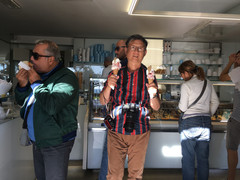
 张英俊___
张英俊___ 5.5千
5.5千 20
20
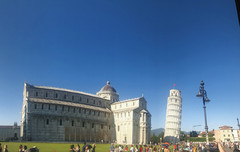
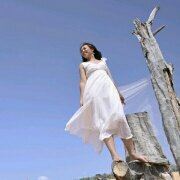 qiqileeng
qiqileeng 1.1万
1.1万 9
9
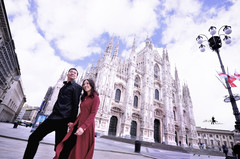

 6.4千
6.4千 17
17
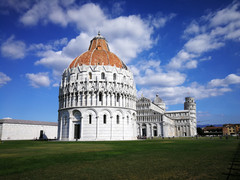
 zzz_0401
zzz_0401 5.9千
5.9千 11
11
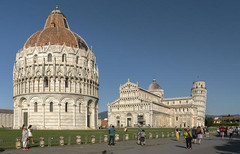
 拾贝里
拾贝里 2.1千
2.1千 0
0
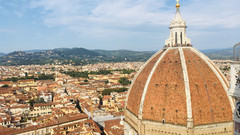
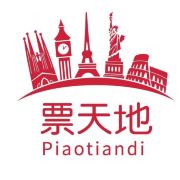 票天地旅行博客
票天地旅行博客 4.9千
4.9千 2
2

 lyd****ong
lyd****ong 2.1千
2.1千 1
1
